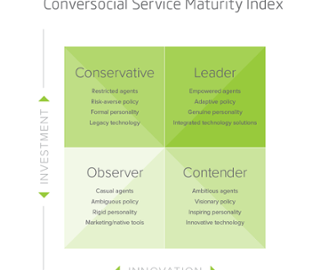Let’s talk about social media maturity: it’s not the ability to hold oneself back from posting viral videos or retweeting silly jokes. Rather, it is an index from which businesses can gauge how well they’ve adapted to and taken advantage of social media to advance their company’s bottom line.
Social Media for Customer Service
Social media is quickly becoming one of the most preferred methods of connecting with a company. Businesses should be privy to the fact that their customers are likely to be present and engaged on social media to begin with, thereby providing a quick and instantaneous route for communication.
On the business end, social media maturity is not limited exclusively to big-name brands with box-office budgets. Whether the correspondence uses public or private social channels, they will surely remember and appreciate the fact that you meet them where they already are.
So long as your customer support on social media remains efficient, humanized and well developed, you’re likely to garner better ROI, speedy responses, low effort, and in channel resolution. With the right amount of investment and innovation, your brand can reach the highest level of social media maturity as a #SocialFirst leader of the pack.
The Value of Social Media: Past, Present, Future
We’ve come a long way since Facebook completely changed the digital landscape just over ten years ago, and social media has become part and parcel of modern life for hundreds of millions of people worldwide. Lately, businesses have been privy to the fact that their customers are largely present on social media and make efforts to address these audiences accordingly. However, many brands still haven’t reached their full potential on social. As Conversocial’s Social Maturity Index states, “unless your social media customer service strategy is powered by an underlying drive to provide exceptional customer experience, you aren’t built on the right foundation for social customer maturity.”
Perhaps you’re limiting the social experience only to the marketing department, rather than offering social customer service. Marketing and service both have stakes in social, and a dedicated platform to respond to your customers and scale is necessary. Maybe you’re not providing the most engaging or relevant content for your audience, or it could be that you’re not adequately measuring or analyzing your social data.
Regardless of where you have the biggest opportunity for growth, it would be in any company’s best interest to seriously invest time, money, training, and other resources in order to become a more socially mature business. Don’t forget the key is to have both investment and innovation, this means that you must be investing with your time, energy and resources as well as have the willingness to take on new solutions, progressive tactics and radical humanity. More than one-half of consumers prefer social customer service. Timeliness and relevance are huge markers of success, and socially mature businesses make the best use of social media to ensure that these two factors are at the forefront of their business strategy.
Becoming a Socially Mature Business

A fully mature brand doesn’t happen overnight, yet a dedicated and consistent attention to the social sphere will advance you along the spectrum, eventually leading to a fully sustainable, socially integrated business. In order to become a more socially mature business, keep some of the following best practices in mind:
- Always make the customer your first priority. Be considerate of their needs, desires, and expectations, whether it’s curating a post or handling social customer service queries.
- Invest in a stable social solution. Prioritize implementing a scalable solution that can grow with your business for the long-run.
- Test, measure, and adjust. Keep track of all social initiatives—including but not limited to tone, timing, networks, and paid efforts—to get a directed, data-driven sense of strengths, weaknesses, and opportunities to improve your social strategy.
- Keep humanity in mind. Few things are worse than automation, scripts, and trite, stale, or mechanical communication in business/customer interactions. Don’t be afraid to get personal by being personable.
- Don’t limit social to only external use. Embed the social aspect into your company’s DNA to ensure that no employee is left behind. Embrace internal social networks to keep intra- and inter-departmental colleagues in close, constant contact.
Now that you know and understand social media maturity, take a close look at your business to see how you, your colleagues, and higher-ups can augment your social strategy in order to become a thriving, socially mature business.
Digital & Social Articles on Business 2 Community(29)







